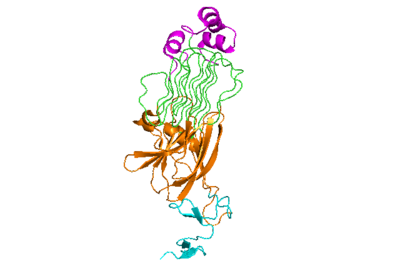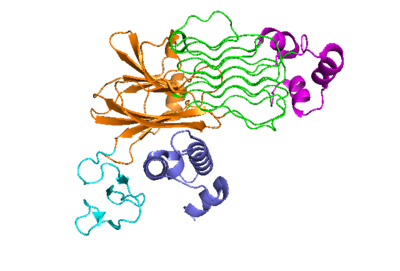Sandbox Reserved 1713
From Proteopedia
| Line 1: | Line 1: | ||
<scene name='90/904318/Alkal1membraneinteraction/2'>Text To Be Displayed</scene>{{Template:CH462_Biochemistry_II_2022}}<!-- PLEASE ADD YOUR CONTENT BELOW HERE --> | <scene name='90/904318/Alkal1membraneinteraction/2'>Text To Be Displayed</scene>{{Template:CH462_Biochemistry_II_2022}}<!-- PLEASE ADD YOUR CONTENT BELOW HERE --> | ||
=Anaplastic Lymphoma Kinase= | =Anaplastic Lymphoma Kinase= | ||
| + | ==Background== | ||
| + | The anaplastic lymphoma kinase was first discovered in 1994 as a tyrosine kinase in a type of lymphoma cancer cell. ALK is a specific type of [https://link.springer.com/article/10.1186/s12943-018-0782-4 RTK] which plays a huge role in transmembrane signaling and communication within the cell. ALK is commonly expressed in the development of the nervous system. Anaplastic Lymphoma Kinase receptor is a membrane-bound tyrosine [https://pubmed.ncbi.nlm.nih.gov/32114309/ kinase]. The ALK transfers a phosphate group from [https://www.ncbi.nlm.nih.gov/books/NBK553175/ ATP] to a tyrosine residue on an enzyme which activates a signaling cascade, and ALK becomes activated when a ligand called [https://www.ncbi.nlm.nih.gov/pmc/articles/PMC5789956/ ALKAL] binds to the binding surface on an extracellular domain of ALK. ALK is an integral membrane protein. Abnormal forms of ALK are closely related to the formation of several cancers. | ||
<StructureSection load='1stp' size='340' side='right' caption='Caption for this structure' scene=''> | <StructureSection load='1stp' size='340' side='right' caption='Caption for this structure' scene=''> | ||
| - | ==Introduction== | ||
| - | Anaplastic Lymphoma Kinase is a receptor tyrosine [https://pubmed.ncbi.nlm.nih.gov/32114309/ kinase] and is an integral membrane protein. ALK transfers a phosphate group from [https://www.ncbi.nlm.nih.gov/books/NBK553175/ ATP] to a tyrosine residue on an enzyme which activates a signaling cascade, and ALK becomes activated when a ligand called [https://www.ncbi.nlm.nih.gov/pmc/articles/PMC5789956/ ALKAL] binds to the binding surface on an extracellular domain of ALK. | ||
== Structure & Function == | == Structure & Function == | ||
Revision as of 03:13, 28 March 2022
| This Sandbox is Reserved from February 28 through September 1, 2022 for use in the course CH462 Biochemistry II taught by R. Jeremy Johnson at the Butler University, Indianapolis, USA. This reservation includes Sandbox Reserved 1700 through Sandbox Reserved 1729. |
To get started:
More help: Help:Editing |
Anaplastic Lymphoma Kinase
Background
The anaplastic lymphoma kinase was first discovered in 1994 as a tyrosine kinase in a type of lymphoma cancer cell. ALK is a specific type of RTK which plays a huge role in transmembrane signaling and communication within the cell. ALK is commonly expressed in the development of the nervous system. Anaplastic Lymphoma Kinase receptor is a membrane-bound tyrosine kinase. The ALK transfers a phosphate group from ATP to a tyrosine residue on an enzyme which activates a signaling cascade, and ALK becomes activated when a ligand called ALKAL binds to the binding surface on an extracellular domain of ALK. ALK is an integral membrane protein. Abnormal forms of ALK are closely related to the formation of several cancers.
| |||||||||||
References
- ↑ Reshetnyak AV, Rossi P, Myasnikov AG, Sowaileh M, Mohanty J, Nourse A, Miller DJ, Lax I, Schlessinger J, Kalodimos CG. Mechanism for the activation of the anaplastic lymphoma kinase receptor. Nature. 2021 Dec;600(7887):153-157. doi: 10.1038/s41586-021-04140-8. Epub 2021, Nov 24. PMID:34819673 doi:http://dx.doi.org/10.1038/s41586-021-04140-8


